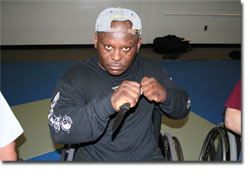written by Joseph L. Singleton

Both an able-bodied person, who is a martial arts instructor, and a disabled person, who is a martial arts instructor must comprehend the knowledge, the philosophy, and the attitude of the martial arts to be a good instructor. They (the able-bodied and disabled instructors) do these in different ways. First, of all, the knowledge of an able-bodied person who is a martial arts instructor, and the knowledge of a disabled martial instructor includes diversity in martial arts. For example, the able-bodied instructor demonstrates skills by mimicking the physical movements used in martial arts, like seeing a reflection in the mirror of a graceful ballerina. However, the disabled instructor’s knowledge is a “conceptional view.” For this reason, the disabled instructor’s view is like following instructions step-by-step in a “how-to” book. Despite this, the able-bodied instructor’s ability to participate fully with the student, or the disabled instructor’s lack of mobility with the student has nothing to do with the knowledge of the instructor. Each instructor can take a student like a piece of molding clay, and create a piece of art.
The philosophy of an able-bodied instructor, and a disabled instructor can be different. For example, the principle that martial arts is important, but not the most important aspect of a person’s life, could be the cornerstone of the able-bodied instructor’s philosophy. On the other hand, the disabled instructor’s theory is that breaking down physical, architectural, behavioral, and mental barriers, is part of the training in martial arts.
Most importantly, the able-bodied instructor, and the disabled instructor should have concerned attitudes as instructors. For example, the able-bodied instructor’s attitude about martial arts might simply be, “If you are not having fun, you are not doing it right.” Yet, the disabled instructor’s attitude about martial arts is that the four-letter word can’t
is a defeat!
To summarize, the knowledge, the philosophy, and the attitude of the able-bodied instructor and the disabled instructor should be shared in theory, and practice by both instructors —
